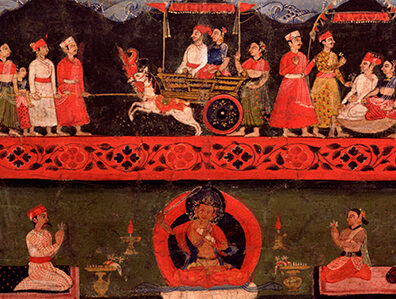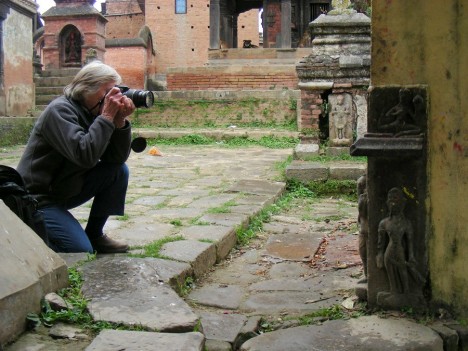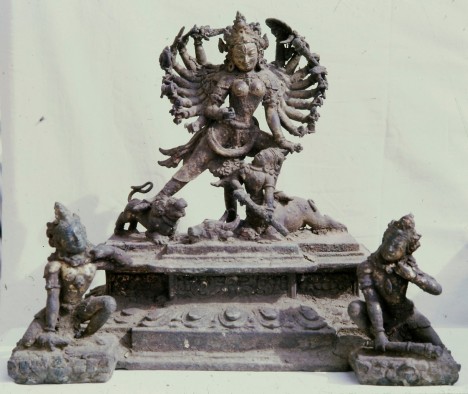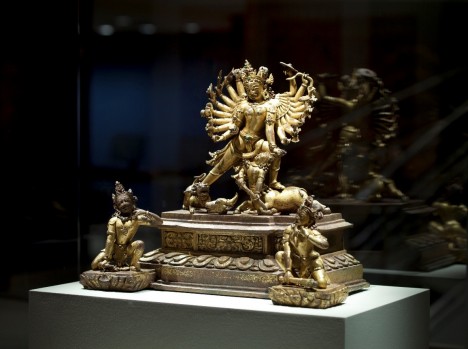


In 2017 the Rubin honored the passing of two preeminent art history scholars in the field of Nepalese art—Mary Slusser and Dina Bangdel. Colleagues, friends, and admirers shared their thoughts and memories of these great scholars. Read their words below and visit the listed resources to learn more.

Mary Slusser photographing at Panauti, December 2, 2007. Photograph by Ian Alsop.
From Patrick Sears, executive director of the Rubin Museum:
I had the great pleasure of knowing Mary Slusser for over three decades. As many who know her will attest, she was an extraordinary person, a gifted scholar and writer possessed of a work ethic—even into her 90s—that would run circles around those a third her age. I was never once disappointed in her advice, her attention, her patience, and her kindness.
I once traveled with Mary to the Kathmandu Valley to work with her on aspects of the soon-to-be museum on the Durbar Square of Patan. While most of the specifics of our time together in Nepal are now obscured, two moments remain vivid: Mary spent the first few days of our trip introducing me to the sights, sounds, personalities, locales, and art. One morning, we were hiking to a small shrine between Kathmandu and Bhaktapur and we happened upon youngsters taunting a starving dog. This diminutive American lit into these Nepalese kids with a fury I hadn’t imagined she possessed. While I’m certain none in the group understood a single word, they nevertheless heard her loud and clear. Then she did an extraordinary thing. She gathered the kids around her and gave them a big group hug. We kept on moving and then the entire group joined in to follow their Pied Piper for the rest of our walk. Always forthright, but with a big heart.
As a pre-trip present, she gave me a tremendously advanced (and very expensive) flashlight, telling me, “You’ll need this. You’ll see.” And she was right. Almost 30 years later that flashlight is still in use today. And I remember her every time it lights my way.
From Dr. Amy Heller, Tibetologist and art historian affiliated with CRCAO, Paris:
I first visited Kathmandu in 1995, with a xerox of Nepal Mandala in hand to use as maps to visit all the Licchavi sites Mary had photographed. Mary had explored so many temples, so many courtyards, finding sculptures, carved reliefs in stone and wood, and caitya. Shortly after, we started to correspond, a letter-email relationship which lasted more than 20 years. Her insights and mentorship will be sorely missed.
Mary Slusser has been a beacon of scholarship, methodology and mentorship for me. I admired her finely honed artistic observations, elegant prose giving precise descriptions as keys to appreciate subtle differentiations, which she documented by her fine photography, in situ. She developed the methodology of working in tandem with Nepalese scholars whose perspective enhanced her own historic assessments, and she brought the Nepalese scholars to the forefront of academia. She was generous in sharing the fruits of her research and the critical questions of her inquisitive mind. I remain tremendously grateful for her guidance, criticism and wit.
From Dr. Gautama Vajracharya, scholar of Newar art and Sanskrit:
With typical modesty, Mary described herself as an enthusiast who ached to unravel the past. But her extraordinary contributions on the complex subject of Newar art and culture of the Kathmandu Valley are so significant that it is difficult to find any work on those subjects without reference to her contributions. Her two-volume magnum opus Nepal Mandala is indeed an irreplaceable work. As I mentioned a few years ago, only a scholar of the younger generation who chooses to undertake a similarly ambitious project, with the same spirit and enthusiasm, will understand the gravity and depth of her lifelong passion.
From Alexander von Rospatt, professor for Buddhist and South Asian studies, and director of the group in Buddhist studies, University of California, Berkeley:
Mary Slusser laid the foundations for the study of Nepalese art, culture, and religion. Her monumental two-volume study Nepal Mandala remains to this day the authority for introducing the history of Nepal and its rich artistic and religious heritage. The thoroughness of her research, her eye for detail, and the graceful prose with which she communicates her enchantment with Nepal make this study not only an indispensable reference tool but also a source of inspiration, and a joy to read. Mary was blessed with a long and productive life, and the field of Nepalese studies will be forever indebted to the foundations she laid with her learned, broad-ranging and incisive writings.
From Michelle Bennett Simorella, head of collections management and registration at the Rubin Museum of Art:
As an undergraduate and graduate art history student fascinated with Nepalese art, I enthusiastically studied Mary Slusser’s publications on Nepal. Years later, when the Rubin Museum’s director asked me if I would like to meet Mary and take her up to the galleries, I was thrilled (and a bit starstruck).
As we were standing in front of one of my favorite pieces in the collection, a 13th-century Nepalese bronze Durga Mahisasuramardini, I was stunned when Mary began to tell me the story of how her sister had acquired the work while visiting her in Kathmandu in 1967. Mary recounted “As was the custom, one evening one of the dealers came by with a few things while she was there. Among them was the Durga image. Thick with grime and offerings of ritual pastes, powders, and food, it very likely had come directly from some family’s private chapel. The asking price was a thousand dollars but after bargaining would likely have dropped to three or four hundred. But to my shock, my impetuous sister said at once, “I’ll take it” and paid the full price.”
She went on to say that her sister brought the sculpture back to Cleveland, had it conserved, and it was simply magnificent. She later sent me a written account of the experience and the provenance since her sister’s passing, as well as photos of before and after conservation from her archive. Hearing an eye witness account of the acquisition and provenance of such an important work, to both the Rubin Museum’s collection, as well as to me personally, was the highlight of my career.

The Durga Mahisasuramardini sculpture before cleaning and conservation. Photo provided by Mary Slusser.

The Durga Mahisasuramardini sculpture on display at the Rubin Museum. Photograph by David De Armas.
A Personal Tribute to Mary Slusser (1918–2017)
Mary Slusser is celebrated for her professional achievements, and for the unique role she played in bringing Nepalese art and culture to a wider audience.
Mary Slusser: Remembrance of things past
Mary’s own account of her accomplished and full life, from growing up in small-town Michigan to her 36 years overseas in the foreign service.

Dina Bangdel (right) with Aju Dharma Ratna Shakya (left) at Kwa Baha, Patan, Nepal. Photo © Kerry Lucinda Brown.
From Kerry Lucinda Brown, adjunct assistant professor of art history, Virginia Commonwealth University, and adjunct assistant professor of Asian studies, Randolph-Macon College:
Dina Bangdel was an amazing scholar, mentor, and friend. My interest in studying Newar art and culture was sparked by a course Dina taught at The Ohio State University on the arts of Nepal nearly 20 years ago. While I intended to focus my graduate career on studying Buddhist art and architecture, it was Dina’s passion and enthusiasm for the art, ritual, and cultural traditions of the Kathmandu Valley that shifted my attention to Nepal.
Dina encouraged my study of Nepalese art and ritual culture at every stage. I followed Dina to Virginia Commonwealth University to pursue my PhD in South Asian and Himalayan art in the department of art history.
Looking back, as much as Dina encouraged my academic study of Nepalese art, she also fostered a love for the people of Nepal and the rich heritage of the Kathmandu Valley. I was fortunate to have traveled to Nepal with Dina on several occasions, documenting art and festivals, interviewing artists and practitioners, and sharing more than a few plates of momos. Dina’s passion for Nepalese art—both ancient and contemporary—was infectious.
Dina will be remembered for her dedication to her students, her research, her community, and her family. The field of Nepalese art has lost a tremendous scholar, but her work and legacy will continue with everyone she inspired.
From Dr. Gautama Vajracharya, scholar of Newar art and Sanskrit:
When Dina was here at the department of South Asian studies, University of Wisconsin, Madison, she took advanced Sanskrit classes from me for four semesters. Later, at The Ohio State University, her adviser John Huntington trained her to be a specialist of Newar Buddhist art. She demonstrated her leading intellectual ability when she curated Circle of Bliss: Buddhist Meditational Art and wrote the catalog for the exhibition together with her adviser and classmates. Subsequently, after establishing herself as an art history professor at Virginia Commonwealth University, she played a huge role in helping contemporary Nepalese artists to achieve the international recognition that they so deserved. She was busy with this new responsibility when she died unexpectedly like the vernal flowering plant, with plenty of buds that never got a chance to blossom.
From Alexander von Rospatt, professor for Buddhist and South Asian studies, and director of the group in Buddhist studies, University of California, Berkeley:
Dina Bangdel did not only study Nepalese art in its myriad manifestations but she was also deeply invested in curating, protecting and promoting the arts of her home country, and in repatriating stolen objects. In her engagement with Nepalese art Dina always paid close attention to the religious and cultural context, and she was particularly invested in the study of the Newar Buddhist tradition. She studied art objects not as dead material culture but as living objects which the faithful imbue with meaning. Accordingly, she invited a large group of Buddhist Vajracharya priests to perform an elaborate mandala puja at the Los Angeles County Museum of Art, when she curated the magnificent exhibition Circle of Bliss, dedicated to the artistic heritage of the tantric traditions of Nepal.
Dina maintained close contacts not only with Newar Buddhists, but also with contemporary artists, whose work she keenly studied and supported, and with Nepalese academics, whom she hosted at her home institution, Virginia Commonwealth University. Through all this she came to serve as a bridge between her native Nepal and the Western academic world, to which she professionally belonged. It was only logical that she eventually moved from the United States to Doha (where she directed the art history department on the Qatar campus of her university) so as to be in greater proximity to Nepal and intensify her work there.
Dina was indefatigable and full of energy, sparkle, and enthusiasm. Her premature death took her from this world as she was in the midst of organizing a major show of Nepalese art that was to show in Paris, Singapore, and elsewhere. No other contemporary scholar has done more for the study and promotion of Nepalese art, and her passing leaves a gaping hole.
From Kathmandu-based artist Sheelasha Rajbhandari:
In mid-January 2017, I traveled to Doha with Hit Man Gurung and Mekh for the Built / Unbuilt: Home / City project, something Dina had been planning with us for some years. At that time, she was intensely engaged in multiple activities, from the opening the Bangdel Foundation, to writing books, to organizing several exhibitions, and handling numerous responsibilities as director and board member of various organizations. But never had we imagined that the project we were working on would be Dina’s very last one.
Dr. Bangdel appeared in public for the last time on March 26, 2017, at the opening of the exhibition “Built / Unbuilt: Home / City at the Kathmandu Triennale. She traveled for the event from the United States, even though she had recently undergone surgery.
Dina will be missed as a scholar, art historian, curator, mentor, art enthusiast, and as a determined and compassionate human being. But her contributions will always be with us.
From Kathmandu-based artist Ashmina Ranjit:
Dina existed between worlds, living and working abroad yet having a strong sense of identity and bond to Nepal. She spoke many languages and lived outside Nepal for half her life but she never left it behind, and even talked with pride about her Nepali accent, the index of her origins. Dina was ambitious in all aspects of her life. She always managed to engage in several personal and professional projects at once. Her expertise was exceptionally varied, having vast knowledge of both traditional and contemporary art. Dina’s wish was to bring Nepalese art into dialogue with a broader, global art community. Traditional and contemporary Nepalese art and artists were not merely peripheral examples of “Third World art,” Dina professed, but living traditions in intellectual conversation with art both inside and outside of Nepal.
Farewell, Bird of Fire!
The Kathmandu Post obituary recounts Dina’s limitless passion and commitment to Nepal in this touching and personal obituary.
In Memoriam: Dr. Dina Bangdel
Virginia Commonwealth University announces the sad news of the passing of their dear colleague and friend Dr. Dina Bangdel, who served as the director of VCU Qatar’s art history department.
In Memoriam: Dina Bangdel, art historian and CAA board member
The College Art Association expresses their thanks for Dina’s contributions to CAA’s board.
Get the latest news and stories from the Rubin, plus occasional information on how to support our work.